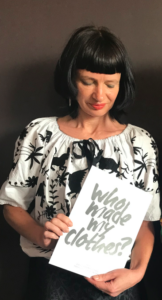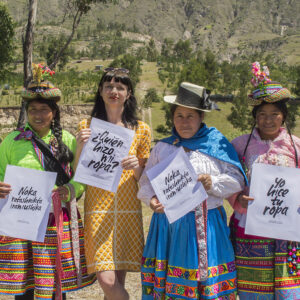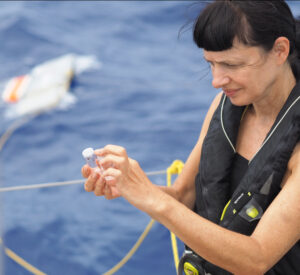Carry Somers: Degrowth starts with the rejection of the fast fashion business model
By Carry Somers, founder of Fashion Revolution | March 19, 2024
British fashion designer, Carry Somers is a prominent figure in the sustainable fashion movement, best known as the founder of Fashion Revolution, a global campaign calling for greater transparency, sustainability, and ethics in the fashion industry. She launched the campaign in response to the Rana Plaza factory collapse in Bangladesh on 24 April 2013, which killed 1,134 people and injured many more. The tragedy highlighted the dire working conditions and environmental damage associated with the fast fashion industry.
Somers’ background in fashion began with her own label, Pachacuti, in 1992, which focuses on fair trade practices and sustainable production methods. Pachacuti, which means “world upside-down” in the Quechua language, demonstrates how the industry can operate more responsibly.
Her work with Fashion Revolution has inspired a global movement, with participants in over 100 countries around the world. The campaign encourages consumers to ask brands, “Who made my clothes?” promoting transparency and accountability in the supply chain.
Here she discusses the fashion industry’s significant impact on climate change and explores pathways towards achieving net zero emissions. Somers discusses the critical role of raw materials, the challenges of transparency within the industry, and the environmental impact of fast fashion. She emphasizes the need for a radical transformation in the industry, moving away from incremental changes to a more sustainable and equitable model.
—
Fashion stands at a pivotal moment: it calls for immediate action, it demands accountability, and it will take immense creativity to achieve the radical transformation – not just incremental steps – essential for building a truly sustainable future.
To meet the goal of net zero emissions by 2050, raw materials are key, as over half of emissions and 90% of biodiversity loss and water stress stem from resource extraction and processing. Yet transparency remains poor. Fashion Revolution’s Fashion Transparency Index shows only 12% of major brands and retailers disclose any of their raw material suppliers, and little over a quarter publish annual progress on the reduction of textiles deriving from virgin fossil fuels. To reach net zero, brands and retailers must reduce impacts across all fibre types, publish Scope 3 emissions data, and track progress transparently.
We hear a lot of statistics about fashion’s environmental impact, sometimes true, often not. Only this week, I read that fashion was going to be responsible for 25% of all carbon emissions by 2050. Like the oft-quoted saying that it’s the second most polluting industry, this claim is undoubtedly a fallacy. But just how polluting is the industry, what is its impact? The truth is we don’t know. But what we do know is that we need all brands, across all price points, to not just adapt but transform if we are to see a fast and fair transition.
We need all brands, across all price points, to not just adapt but transform if we are to see a fast and fair transition.

Carry Somers
For too long the industry has hidden beneath generalized claims, boasting about their business values and positive progress without sharing much about the things that go wrong, the systemic challenges they face and the honest results of their efforts to protect human rights and the environment. If we are to meet climate change targets, fast fashion brands must focus less on cultivating eye-catching headlines, and invest in developing genuine, measurable baselines and targets, backed by verifiable data that considers the full lifecycle of clothing and its impact throughout the value chain, to true end of life.
The sector must also co-design solutions with its suppliers, because no single part of the industry can make a big enough impact to transform the system alone. The industry’s top-down approach to sustainability solutions means it too often sets science-based targets without consideration of feasibility and context, placing the responsibility for fixing fashion onto suppliers. The industry must work together across all areas and with outside specialists to enact meaningful change. Attention needs to shift away from target-setting towards finding ways to transform the whole financial, cultural, and social environment, tackling inequalities along the way. This is what will enable climate action – and yes, reaching targets – to happen.
And in terms of sustainable fast fashion brands, the term sustainable fashion alone is an oxymoron, let alone adding the word fast to it! Degrowth starts with the rejection of the fast fashion business model.
So who’s leading the charge? On one side, we have innovators like Galy revolutionising how cotton is grown by addressing the key issues in farming. Galy’s cellular agriculture process, or lab-grown cotton, eliminates not just harmful insecticides and pesticides, but reduces water use and is fully transparent. Galy’s cotton uses 80% less resources – that is significant. And then we have innovators like Cyndi Rhoades, founder of Worn Again, who has been working to create value from waste for the past twenty years, supporting the shift from linear supply chains to a circular system. Both are essential components of driving progress to net zero.
Just because a material comes from a plant or animal does not mean it will break down harmlessly in the environment.
A recurring assumption I see on my socials these days is that natural fibres have little or no negative impact on the environment. But just because a material comes from a plant or animal does not mean it will break down harmlessly in the environment. Natural fibres have been mostly neglected in scientific studies of marine and freshwater pollution, but we must consider the full lifecycle and impact of all fibres, not just their origin.
Some fibres will pass through chemical processes, regeneration for lyocell and viscose, sometimes mercerisation in the case of cotton, which gives them a different cell structure, cellulose II, which does not occur in nature. As a result, there is little in nature that knows how to break it down.
Further modification can occur through chemical treatments such as bleaching, dyeing, the application of repellents, flame retardants, softeners, antimicrobials. All of this chemical processing means that most so-called natural fibres do not simply disappear in the waterways and oceans. In fact, scientific studies have shown natural fibres to account for over 70%, and in some cases over 80%, of the total fibres found in samples collected from freshwater, marine waters, animals and the atmosphere, echoing the findings of sediment samples I collected from Rudyard Lake with a team of scientists from Keele and Loughborough Universities. And natural fibres are not only prevalent, but persist for long periods of time. We are currently working on a scientific research paper to share our findings.
Imagine a world where we didn’t even need to dye our jeans.
I’ve recently returned from a two month Churchill Fellowship to Latin America researching plant fibres and dyes. On my travels, I spent days in laboratories developing biomaterials. I spoke to researchers cross-breeding native coloured cotton to increase staple fibre length. I visited remote communities high in the Andes using invasive species to make plant dyes. And I met a woman spinning kapok, a tree that produces 40-50 kilos of fibre a season and thrives in dry years. During my trip, I had the opportunity to visit Los Nacimientos in El Salvador, one of two certified organic indigo farms worldwide. Jeans are the most commonly worn item of clothing, and I couldn’t help wondering if those fibres in our lake sediment had been dyed with natural indigo, would they have broken down more readily?

Carry in Peru, researching native coloured cotton.
In Peru, I was researching native coloured cotton which grows in beige, pinks, yellows and greens. In the ethnobotany department of one of Lima’s universities, I saw a photograph of blue cotton growing in the Amazon – no one seems to know exactly where it is, but I am keen go and find it! The following week, I was with the Yanesha community in the rainforest, where I was told they once grew black cotton. And I began to imagine a world where we didn’t even need to dye our jeans.

Carrry collecting sediment samples from Rudyard Lake with a team of scientists from Keele and Loughborough Universities.
Natural fibres should not be disregarded, both in terms of problems and solutions, but we must fill knowledge gaps to understand both how such fibres are transported and the rate and fate of the chemical pollutants they carry. We need to understand the full and ongoing impacts of all fibres and materials if we are to ensure our well-intentioned efforts to reduce plastic pollution aren’t replacing one environmental issue with another.
When it comes to sustainable fibres, I have to admit that Pachacuti—the Panama Hat brand I founded in 1992, now run by my husband—sets a high bar. The Carludovica palmata fibres are harvested from community-owned, biodiverse plantations where plants are grown without the destruction of primary forests, in organic conditions, with no watering or irrigation. Once a plant is established, which takes around 3 years, it can be cropped once a month for up to 100 years. As part of our pilot research for the 3-year European Union Geo Fair Trade Project, we collected 70 social, economic and environmental indicators every year, including the energy, 8.9 MJ, and water, 24.5 litres, to make one hat, from plant to finished product—a fraction of the carbon and water footprint of an equivalent cotton hat.
There are a lot of other brands I admire, and like Pachacuti, they tend to be slow, small, artisanal in focus. Nishanth Chopra of Oshadi aims to cultivate a regenerative fashion system from the soil up, building a seed-to-sew supply chain in rural India. Founded by Nishanth Chopra in 2016, the brand has a 50-acre regenerative cotton farm at its heart. Their one simple ethos is to give back more than they take.
We need to shift from a top-down approach to collaborative co-design.
Ultimately, we need to shift from a top-down approach to collaborative co-design. Not only is co-design crucial to driving widespread reform, it will also help address the fragmented and siloed measures preventing comparability, one of the goals of the Impact+ project.
League of Artisans is a new organisation I co-founded in 2022, which aims to mobilize the power of co-creation and collaboration, amplifying artisans’ voices, advocating for craft communities, and promoting artisan’s skills as a vital response to global challenges. I’m particularly excited about one of the projects we are working on in the year ahead, a British Council funded toolkit to reduce the exposure of micro-businesses and women-led creative enterprizes to climate-related disasters, making sure they are climate-prepared, and helping them recover and strengthen post-disaster.
Our approach is not expert-led, or top down. Outputs will be co-created through creative dialogue, through knowledge collection and sharing, founded on the premise that artisans are the best teachers. Documenting experiences from the Philippines and beyond, both pre and post-disasters, we will incorporate artisans’ experiences into needs assessments and share success stories from global communities with the aim of replicating good practice.
Moving forwards, we are looking for funding to translate and localize the toolkit for other countries, drawing on their lived experience. Forming meaningful relationships with smaller partners, such as artisans in rural communities, engaging in a genuine dialogue, and sharing information in ways that are mutually beneficial, can help address the complex, interrelated issues we are facing, and shift the power asymmetry along the way.




